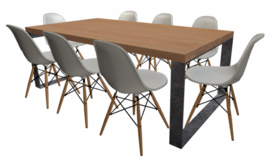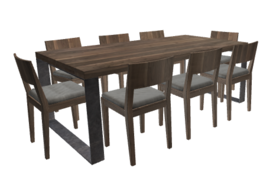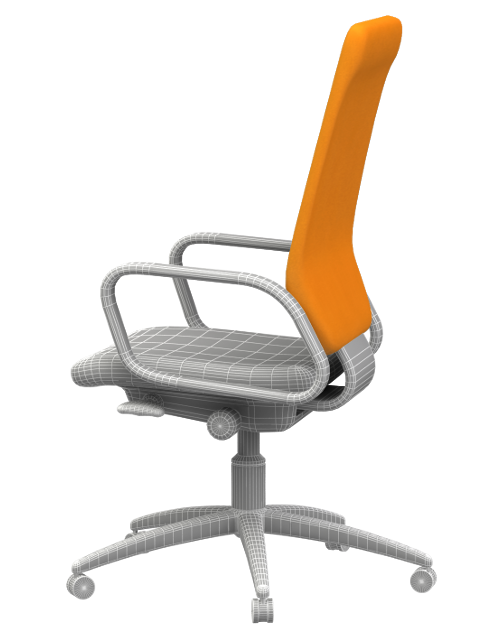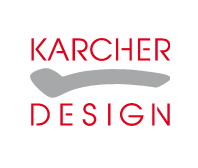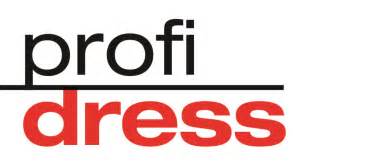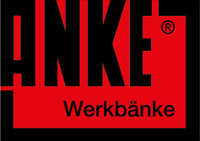3D Configurators are opening up new markets
For certain highly personalized products, distribution via online channels has been difficult and the sales figures correspondingly low. Three-dimensional (3D) product configurators with realistic animation provide a remedy for this situation! Customers can use 3D Product Configurators to independently configure products that could so far only be sold with great sales effort. Quickly configure and order a new sitting accommodation or use your smart phone to design "your" perfect car – what was still unthinkable 20 years ago is now possible and increasingly used. Made-to-measure products were once the epitome of luxury, but now we can configure individual favorites with a few mouse clicks and have them delivered to our doorsteps.
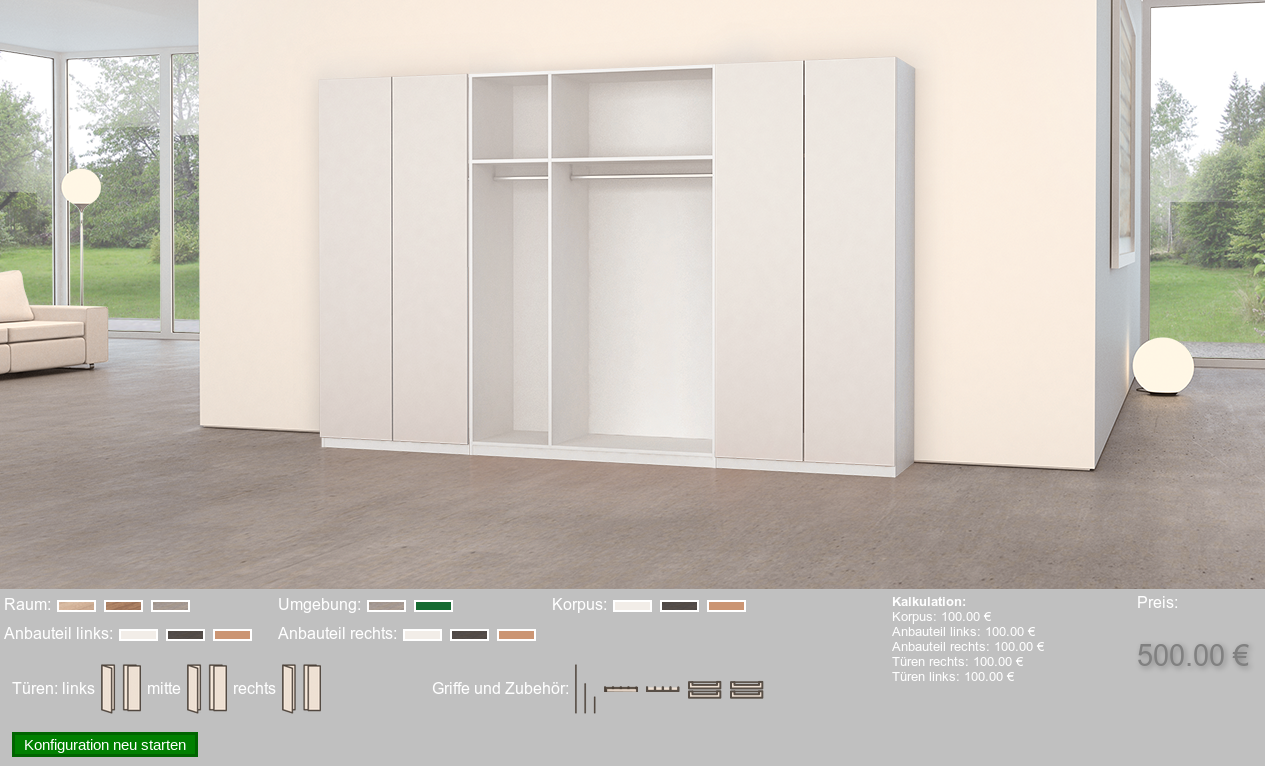
Illustration: 3D Product Configurator for furnitures - selection of a color variant.
A standard online shop works only to a limited extent for customized products. Customers want their personal buying experience and competition on the market of online retailers is huge. Stand out and target your customers is thus the motto for every online retailer.
Spatial visualization in real time
In 2005, eCommerce sales in the b2c sector were still at an annual 13.8 billion euros; by 2014, it had already tripled to 39 billion euros – and rising. The Internet allows customers to compare prices and quality, read testimonials and share experiences. Only after extensive research, the customer takes the decision for their new product. The more expensive a product is, the more extensive is the procurement of information in advance of a purchase.
Video: 3D-product-configurator for workbenches
Companies are, of course, already responding to the altered consumer behavior:
Any professional online providers attracts and keeps customers with a progressive website, a user-friendly online shop, a positive public image and a reliable customer service. For many products, a product description that is as extensive as possible and a series of product photographs is enough. But for more complex products, for which a large number of variations is possible, this is not enough by far. Here, the new preferred discipline on the highly competitive market is 3D Product Configuration enabling the customer to "create" the product optimized for their needs. Customers can assemble their products in real time and order them directly.

Illustration: 3D Product Configurator for furnitures - selection of drawers and other components.
What exactly can I configure with a 3D Configurator?
Basically everything – manufacturers and dealers can use configuration systems to sell anything from unique footwear to individual strollers to a complete single-family home. With a good product configurator, powerful Servers, appealing photo montages, live-generated 3D graphics and an easy handling, it should be possible to attract new demanding customers with impressive configuration possibilities. However, the successful operation of an online configurator often fails because of small things, and dealers using inappropriate software might invest in a loss-making business.
Target group, products and design are crucial
To find the correct configurator in each case, the following points should be considered:
The dealer must first understand who they want to reach with their products. A target group analysis is crucial; tech-savvy customers are often unimpressed by fancy graphics, but rather want to see the essential information at first glance. Products where the design the most important feature must convince on a visual level. So, the demands of the customers are the decisive factor for the choice of a configurator.
One thing, though, is common to all product configurators:
Their handling should be as simple as possible. Ideally, a customer surfs the Internet, finds the website of a dealer, discovers the configurator, and gets everything they need – with only a few clicks. Playing around with the different versions should come along with a certain "fun factor" for the customer to remember it. If people are stressed and challenged in their everyday working lives, the configuration experience should help them relax and not be annoying and time-consuming. Hence, fast loading times are another decisive factor that makes customers stay on a website. If an online shop offers simple products, this is not an issue. Many items do not offer an infinite number of variants, but are only configurable to a limited extent.
Items that are too complex – if we take the extreme example "house" – are also too difficult to implement in a 3D Configurator. This is due to the great diversity of variants; in this example, everything from the choice of the basic layout to the color of the front door is individually configurable. Here, 3D Configurators are more of a hindrance, since the configuration scenario takes too long and the customer will not get an interesting product within a few minutes.
It is therefore better to use them with products that require 3 to 5 configuration settings to achieve a sustainably different design or an optimized functionality – in the case of furniture, cars or bicycles, but also for medicinal products or the industry configurators are therefore helpful tools that support or even enable sales transactions.
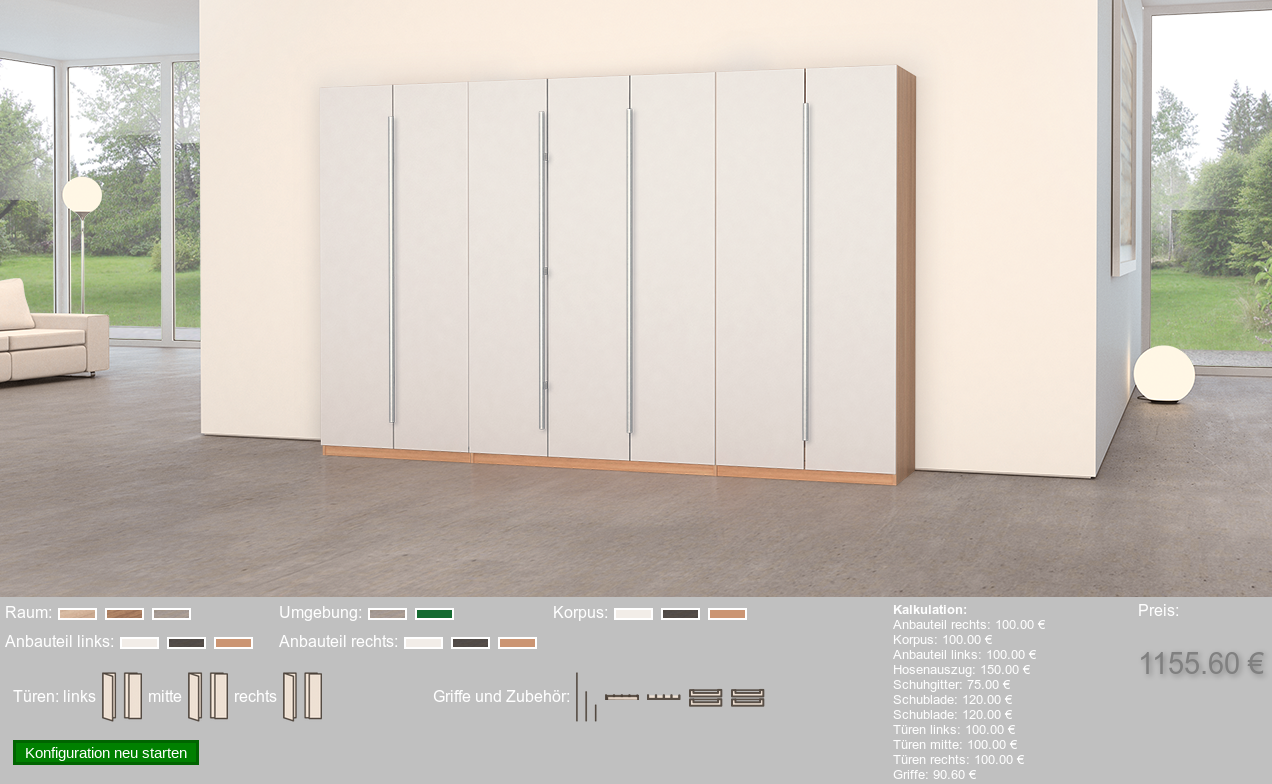
Illustration: 3D Product Configurator - completely configured product including price calculation.
Since 3D Product Configurators work on a visual basis, eye-catching, appealing graphics are absolutely critical. Products must be presented in the highest possible image quality with the possibility to view them from different angles. A zoom feature allows to get a more accurate picture, as even the smallest details become visible. Therefore, the quality of the 3D animation should be as high as possible.
Product design and marketing use a single source of data
For variant products, it is therefore advisable to work with 3D animations the have been generated once in 3D during product design and can then be used with any number of product variants. This will save production costs for marketing purposes, since the product has been completely designed on the computer and many marketing materials as well as the 3D Configurator can be created directly from these data.
The variation possibilities such as surfaces and colors are taken into account directly during the design phase for via textures. Ideally, not even a sample of the real product has to exist. It is sold directly based on the design data.
The color and material variants are designed on the computer and entered in the configurator. With the image material produced by a high-quality product configurator, the customer should only be able to see a slight difference between the animation and a photograph.
An additional criterion for customers is to see all costs at a glance during the whole process. Prices for individual components should be displayed during configuration and also the total amount of all components chosen so far should be continuously updated and shown.
So customers can focus constantly on their budget and will not be deterred by a much too high total amount at the end.
Clear benefits through 3D Product Configurators
The implementation of a 3D Configurator can mean a high investment, which is, however, often very rewarding. The benefits are obvious:
With a suitable configurator, dealers will secure a unique selling point (USP) thereby sustainably differentiating their online business from their competitors'. In addition, a product configurator works independently of place, time and staff. There are no long lines of communication and inconsistencies or disagreements can be prevented. The dealer can also optimize sourcing and production planning, produce on special request, reduce stocks and thus also save storage costs.
Through a 3D animation, the customer remembers the product experience – with a positive influence on their purchasing decision. Dealers can thus cater to individual wishes and approach customers in a way that is geared to the respective target group without any major long-term efforts. For certain products, the (online) sales via a product configurator is without any alternative; the only alternative option would be cost and time-consuming personal (offline) meetings. Dealers would naturally tend to avoid the latter or limit it to the trickiest cases only. Product Configurators allow customers to largely design their own a product in advance. Usually, the conclusion of the sale only requires minimum personal sales efforts.
3D Product Configurators can thus offer 24/7 service and also foster the individuality and creativity of customers – and thus also customer loyalty. Disappointed and dissatisfied customers are automatically deselected from the dealer's customer base. This will, as an additional positive effect, decrease rejection and churn rates.
Conclusion: 3D Product Configurators raise potentials
The use of 3D Product Configurators can develop completely new market segments for the online trade. Where until recently, only a complex customer advisory services led to a successful sale, demanding clientele can now be attracted without frictional loss and with high accuracy via online configurators. This includes, of course, the optimum mix of customer advice and independent action of the customer. And always remember: Customers must reach their goal with just a few clicks!
Contact
Sepia GmbH & Co. KG
Ernst-Gnoss-Strasse 22
D-40219 Düsseldorf - Germany
Phone: +49 211 51 419 75
Phone alternative: +49 211 74 958 712 0
E-Mail: info@sepia.de
Looking for consultation or a web demo?
Get it here.
3D-Configurator for Furniture
Example: dining table. Design, width, depth, material and chairs are configurable. Dynamic price calculation.

